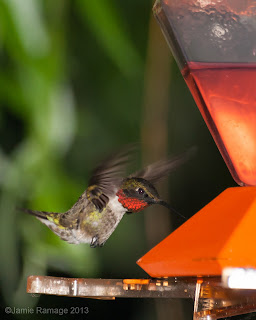 |
| Left, using R-72 filter - Right, naked lens of Sony Mavica CD-500 - using a tripd |
Still messing with the whole infrared 'thing'... The image here shows a shrub in our back yard. Obviously one half of the image is I-R and the other, not. The falling snow doesn't appear in the I-R version due to shutter speed (2.0 sec vs 1/1,000 sec for the colour version). Clarity seems to be an issue here to, though I thought I'd focused properly. The Mavica uses a 'live viewfinder' only and it was bright out, so I just slapped the auto focus on - that may have been part of it. In any case, this part of infrared photography is (pardon the pun) seeing some light. I mean, look at the shrub. The camera is obviously seeing some I-R light reflecting off the branches.
I also bought a Sima SL-201R IR 'night vision' light for video and photography. The thing is supposed to light up to about 70 feet - I can't get it to light even one foot away! I gave it the full three hour charge they ask for as you first open the package - and you can see the LEDs light up (even with the naked eye) if you look straight at it. Aim the panel at a camera lens and you can plainly see them - though, they're not AS bright as the LED in my TV remote when I flash that at a camera lens. Hmmm...
For an experiment, I took the filter off the camera and just held the filter in front of my eye. Then aimed the Sima I-R light at the filter (and eye). I could see the LEDs pretty well. Next, I aimed the LEDs at my leg, white paper and other things - no light bounced back to the camera. So, I removed the filter from the camera and repeated the experiment. ...Same results. Now I'm really confused! How can it appear in the lens when aimed directly at the lens, but nothing else lights up? Is it just a very weak (eg: faulty) light? Still a lot to learn, I suppose...
Any hints out there?



